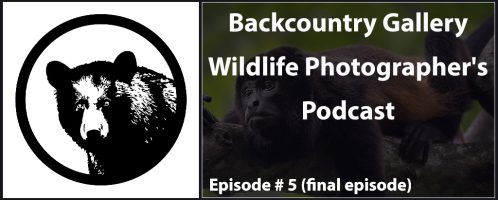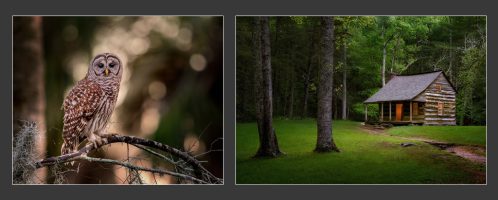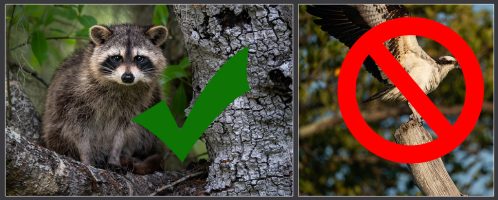It’s here – podcast #2!
In this episode, we’ll start with a quick followup to episode #1 to add a little clarification to my Z series analysis and shadow pulling. Then we’ll jump to a quick tip that will cover a simple but effective tip that’s sure to help minimize mistakes in the field.
In the Q&A section, we’ll talk about gear and locations for Yellowstone National Park, then we’ll tackle a common RAW problem in Lightroom, and finish up with a rapid-fire Q&A about the logistics of shooting down low.
The podcast is available below, on iTunes (click here), Google Podcasts (click here), and on Spotify (once they update their feed – search Backcountry Gallery).
TOC:
00.01 – Intro and followups
05.29 – Settings Check
08.10 – YNP Gear & Locations
15.38 – Unsupported RAW in Lightroom
19.19 – Getting Low And Dirty
Podcast: Play in new window | Download
Subscribe: RSS
.
Show Notes
My Books / Videos – Click Here
ISO Insurance Article – Click Here
My Tripod: RRS 34L MK2
My Gimbal: Wimberley WH-200
Quick Release System Video – Click here
Adobe DNG Converter – Click here
Lightroom Supported Cameras – Click here
PS – If you enjoyed this post, I think you’ll REALLY like my e-books and video workshops! Thousands of pages and hours of videos filled with tips, tricks, and techniques – all my best content! Check ’em out – click here (hey, it’s free to look).




The way this service handles payment flows is remarkable. It’s efficient, secure, and offers all the tools I need. I’ve recommended it to friends and family as well. See why it’s considered one of the best solutions for payments worldwide top 1. The customer-centric design ensures it’s easy to use even for someone who isn’t tech-savvy.
Great – thanks again for helpful information, some kind of padding for your knee is good as you mature in age!! Thanks for information about Yellowstone!
Steve, I decided to listen to this second podcast as I felt I was not as engaged with the first one. I think it’s just a bit of training on my part as most of us now require/expect the visual stimulus to go along with the presentation. I enjoy most everything you share with your followers and will continue to be a subscriber as I’ve learned a lot from you and those asking questions.
Steve, Thanks again for a very informative and entertaining podcast – fire ants, indeed! Re settings. I made the mistake of pre setting my new to me D7100 (U1/U2) before going to the Kruger National Park last June and having totally inappropriate settings for the birds and animals I saw. Elephants drinking at 1/4000, +1/3 EV, f6.3,ISO 3200 – this was for BIF! Just rushing to get into position made me make all the mistakes you described. I’ve now abandoned the presets and moved to your M mode suggestions with much better results – looking forward to the new year… Read more »
Great to hear 🙂 I too found that when I went with M + Auto ISO things were smoother 🙂
Re knee pads. I have started to use tactical pants with build in knee pads. (same kind first responders use) tough, comfortable, and the build in knee pads are barely noticeable when hiking and not really noticeable when going to get coffee.
Check out “Fundytactical.com”. I use Stryke pants, Close cell insertable knee pads extra. Two different weights of knee pads available. I use the heavier ones. Easy to switch between pants. Keeps me in the field and in position longer. “Use what works”… very wise.
Thanks – I’ll check them out!
Check the setting – my addition – forget to remove the VR when you go from handheld to tripod or the reverse scenario.
Hi I leave it on Sport VR, doesn’t affect the focus on higher shutter speeds.At least on Nikon.
I’m surprised to hear on this forum the use of Lightroom. Nikon originally came out with Capture NX which was okay for editing most of my photos. I don’t need the power of Photoshop because few people who view the photos will ever notice the difference that one can create in say Photoshop. Then Nikon seemed to want to get out of the photo editing software business so most people switched over to Lightroom and have some of the issues like converting NEF files. However, Nikon has since came out with Capture NX-2 and Capture NX-D which gives me all… Read more »
Lightroom is significantly more powerful for both post processing and digital asset management (i.e. – sorting photos). In addition, I’ve always found Capture NX (any version) to be much slower to use – at least on my Macs (and I have higher end models). The truth is, if you take the time to learn what you need about Lightroom, it’s a far better tool in my opinion.
While I agree that Lightroom and then Photoshop are more powerful editing programs my point is this level required for 99% of people who view our photos? Yes, we photographers look for qualities that most people don’t and the commercial world is even more particular. But the general public to me is only interested in content (ala any cell phone photo is acceptable) and unless we point out these unique items that we use in editing programs they don’t know (or even care) about. I share photos all the time and comments are usually only about content, not composition, or… Read more »
Sorry for the delay in getting back – I was on vacation (one week a year, I take completely off). I agree that for some the Nikon offerings may do all they need. That’s why we have so many choices. 🙂 I like the flexibility and cataloging ability of Lightroom and the extra features that allow me to process the images the way I want. Also, while I agree that the general public doesn’t necessarily go much beyond content, they can tell the difference between bad, good, and great images. They may not be able to articulate just why they… Read more »
Thanks for the reply. Lightroom does have a superior filing system and for as many photos that you take that is s priority. Aside from that I am curious as to what other features do you use regularly in Lightroom that NX doesn’t include? I’m not a layers person and while there are more special effects in Lightroom than in NX-D and NX2 I usually don’t use these features as the photo can become too artificial. Anyway I appreciate the your input.
Quite honestly, there are dozens, maybe hundreds of things you can do with Lightroom that aren’t available – or work as well – in Capture NX-D. A few in the develop module are things like clarity, texture, dehaze, HSL adjustments, and sharpening masking (this one is HUGE for me) – and those are just basic adjustments (also, I’m not sure NX-D even has a vibrance option, just saturation). I also use the adjustment brush all the time – as well as the radial and gradient filters. Some of these controls and options are critical for me to get the look… Read more »
“Check your settings” Hah! How many, many times have I fallen into this trap. I’ll work with my camera in my office to learn the different features of it then forget that I did. When I take the real photos initially I can’t understand why they are so far off until I “Check my settings”.
I’m enjoying the addition of a podcast, keep it up! Lots of great tips, thanks. Happy Holidays
Hi Steve, I have a question when using the Adobe DNG convertor, as I do use Lite-room 5.
Each time the images are converted they are numbered from 1 onwards.
Is there a way to keep the original file number or keep the numbering consecutive,
instead of having lots of images with the same number?
I always look forward to your Vid’s and Podcasts, I pick up lots of tips and luv your sense of humour.
Have a great Christmas .
Cheerz Robin
I honestly haven’t used the DNG converter enough to say – I always keep my images intact. I’m away at the moment and can’t download to see, so I don’t jus don’t know…
That said, I think you can rename the files on import Lightroom 5 (you can in 6 and the CC versions, 90% sure you can in 5 as well). That’s probably the best way to go.
Enjoying the podcasts! And hope you have a good Christmas!
Thanks – Merry Christmas to you too!!
San Francisco Is Cold – S-F-I-C is a great mnemonic device to frequently and quickly check camera settings in the field: SHUTTER, F-STOP, ISO, COMPENSATION. “”The coldest winter I ever saw was the summer I spent in San Francisco.” (Quote attributed to Mark Twain)
Thanks – that’s clever!
I have taken many great shots of the bison using the 80-400mm lens that would not have been possible to take with a longer 500mm or 600mm lens. This includes interaction between two competing males that were charging and moving around a good deal. Only with a hand held lens and shorter focal length was I able to capture the action. The 80-400mm on a D850 or DX camera is perfect for YNP.
There are exceptions to every rule, and that’s why I recommend, if you have space, to take a shorter, mid-range lens. I prefer the 300PF, but the 80-400 would be a good choice. However, most of the time, I find the 500mm and 600mm focal lengths to be a better choice. Last time I was in YNP I shot exclusively with the 500PF (I was doing a review) and never felt I needed anything shorter the entire week – longer yes, but not shorter 🙂 And some of those images were of bison, all depends on the circumstance – and… Read more »
Reviewing my bison and elk photos from YNP the majority were taken with focal lengths from 150mm to 300mm during the summer and fall months and during the winter my bison pics were taken with focal lengths ranging from 80mm to 300mm and most were at 200mm or less. Minimum distance of 75 feet and at this distance I do not need 300mm to get a full body shot and need 200mm or less if photographing two or more in a group. In the snow to get the overall environment of these animals 80mm is often what I have found… Read more »
I suppose it also depends on your target animals too. I very seldom stop for a bison anymore, instead seeking out coyotes, wolves (still working on that one), bears, etc. I’ll also stop for a nice bull elk, bighorn, or a pronghorn buck (don’t know why, I just really like pronghorns). So, most of my subjects tend to be at longer range. I agree that often bison are better with shorter glass. Although, it’s funny; the last couple bisons shots I did were of one running and a close-up of one behind a snowy sage brush – both at 500mm.… Read more »
Awesome! As you know, I’ll be spending a month in Yellowstone next fall, so that info was great for me. How about some prime shooting locations at Custer State Park/around the Black Hills?
Honestly Eric, pretty much anywhere in Custer is good! I’ve seen wildlife all over. The wildlife loop road is the “main” area I guess, but you can see critters all over.
In addition to checking settings in the viewfinder frequently, I find it very useful to have a standardized review of switches and settings every time the camera comes out of the bag. Top button review: look at LCD while pressing every button on the top of the camera to quickly assure that every setting is where it should be. Then other controls on the sides and back (auto-focus still selected?, memory card empty and formatted?, exposure mode correct?, shutter mode correct? menu bank settings as intended?, etc.). Then a quick look at switches on the lens (vibration reduction, focus range… Read more »
Excellent suggestions! Thanks!